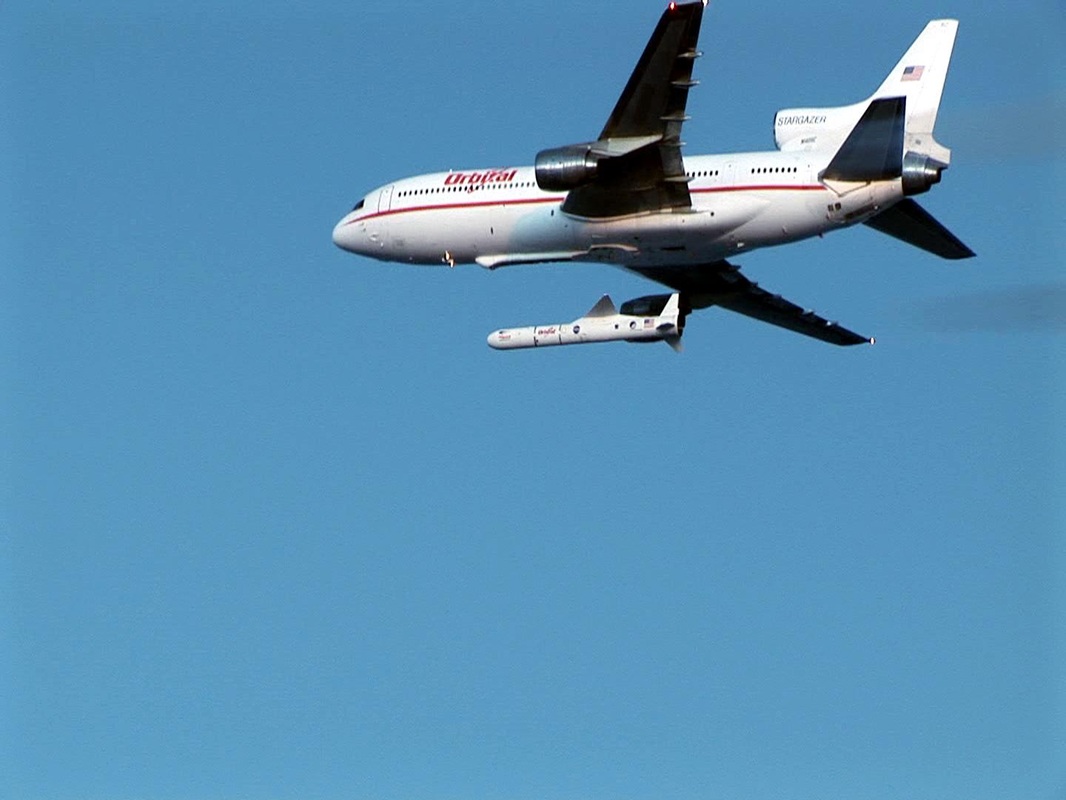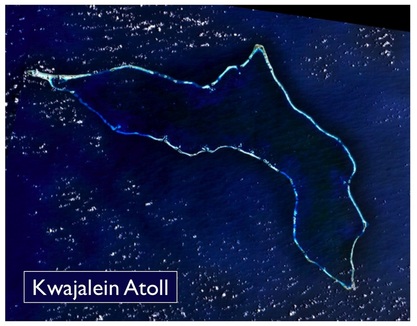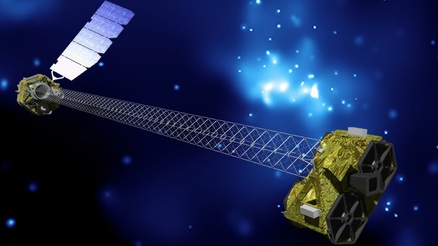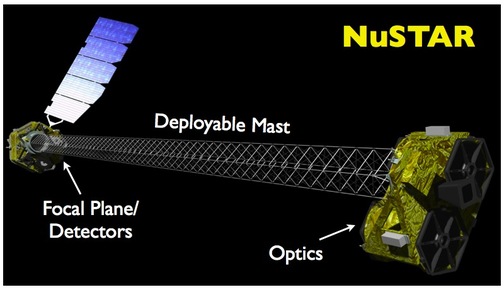 NuSTAR – Mission
NuSTAR – Mission
Operations & Timeline
Launch

NuSTAR will launch aboard a Pegasus XL Rocket from the Kwajalein Atoll. Kwajalein is the world’s largest coral atoll, with a total land mass of 6.22 square Kilometers. It consists of 97 islets surrounding a 840 square Kilometer lagoon. The atoll is part of the Marshall Islands which are located halfway between Hawaii and Australia. The Republic Marshall Islands is independent since 1986 but has strong ties with the United States and hosts the Ronald Reagan Missile Defense Test Site on Kwajalein.
The Pegasus Rocket will be deployed from the Stargazer (L-1011) Aircraft at an Altitude of 12,200 Meters (40,000 feet). After release, the Vehicle will be in free fall for five seconds in order to safely drop away from the aircraft before igniting its first stage. The point at which the Rocket is released is predetermined and the Aircraft has to be in an exact position concerning location&altitude, speed and velocity vector. After Ignition of the Orion 50S, the Vehicle Pitches up and starts powered ascent. During first stage flight, vehicle control is provided by the tail fins. The Delta Wing provides some lift during atmospheric flight. 1 Minute and 8.8 seconds later, the first stage shuts down and separated with the tail fins and delta wing.
Second stage ignition follows. Attitude control is provided by Thrust Vector Control of the Orion 50 Engine for Pitch and Yaw Control and Nitrogen Thrusters on the third stage for Roll Control. Second Stage Burn time is 1 Minute and 9 Seconds. While being powered by the Second Stage, the Vehicle initiates Payload Fairing Separation when the Spacecraft has left the Atmosphere. After second stage burnout, the Upper Composite of the Rocket separated and the final stage ignites its Orion 38 Motor. After 68.5 seconds, the stage will have burned out and the vehicle will be in orbit. The NuSTAR Spacecraft separated from the Launch Vehicle which completes its job at that time.
Once released, NuSTAR will deploy its Solar Array and transition to its on-orbit mode. During its first orbit it will make contact with a ground station and send telemetry to enable Mission Controllers to determine wether the vehicle is power-positive and in good condition. This wraps up the orbital insertion portion of the Flight.
Targeted Orbit

The Kwajalein Atoll and the Pegasus Rocket have been chosen for this mission for two reason. Pegasus XL is a small launch vehicle with low launch costs to support the small budget of the NuSTR Mission. The Rocket can launch from many different position and reach a variety of different orbits including a nearly equatorial orbit when launching from Kwajalein. NuSTAR requires an operating orbit with a low inclination.
NuSTAR operates from a 575 by 600-Kilometer Orbit with an Inclination of 6 Degrees. This Orbit avoids the SAA – the South Atlantic Anomaly. In this particular region, the Earth’s Inner Van Allen Belt makes its closest approach to the Earth’s Surface. Satellites in Low-Earth Orbit will experience the effects of intense particle radiation. For high-energy X-Ray Telescopes like NuSTAR, this is problematic since a high level of radioactive background is produced in the detectors of the Spacecraft. This noise would mimic the cosmic X-Rays that NuSTATR is studying. The desired Orbit of the mission avoids the SAA for a large extent and only skims it during some orbits.
Mission Operations

Checkout and Commissioning
After a successful Orbital insertion, the NuSTAR Spacecraft undergoes a short Checkout and Commissioning Phase with a duration of one month. This portion of the mission begins with basic vehicle checkouts and instrument activations as well as performance validation. Also in this phase, NuSTAR will deploy its Mast and teams will analyze the alignment of the Vehicle’s optical axis and plan the one-time adjustment. This operation is conducted to align the optical axis using a mechanism that is described on our Instrument Site. After the alignment, the Laser Metrology System will be calibrated and checked to prepare it for mission support. Additionally, the first month if the mission gives personnel on the ground the opportunity to familiarize themselves with actual mission operations, communication patterns and spacecraft control. One month after launch, the Spacecraft begins its primary mission.
Primary Mission
The primary mission is expected to have a duration of two years, however only 18 months of science activities are planned to accommodate targets of opportunity which are a major part of the flight.
The Satellite is operated from the Mission Operations Center at UC Berkeley. Spacecraft Communications are provided via the Malindi (Kenya) Ground Station that is operated by the Italian Space Agency. Up and Downlink are provided by the Tracking Station that receives a Spacecraft Communication pass once every Orbit (~90-Minutes). After the initial on-orbit commissioning phase, commanding via the Station will be rare as most science targets will be viewed for one week. Data downlink is expected several times per day. Targets of Opportunity will be supported on a best-effort basis and teams should be able to command the NuSTAR Spacecraft to study ToO’s within 6 hours. As the Mission Operations Center is not staffed around the clock, commands could take up to 12 hours to prepare in some cases.
For NuSTAR, the total expected observing efficiency is 50% for typical targets and up to 90% for targets near the Poles. 80% of the sky are accessible for the Instruments at any given time in the mission which makes mission planning and ToO response fairly uncomplicated and efficient.
Nominal Mission Operations include coordinated studies with other space-based telescopes and ground based telescopes to obtain full data sets of targets and not only the high-energy X-Ray profile that NuSTAR provides.

Mission Duration
The primary Mission of NuSTAR is planned to have a duration of two years including 30 days of on-orbit commissioning and 18 months of pre-planned science activity. The remaining time will be spent studying targets of opportunity.
After these two years, an extended mission of unknown duration is possible. Mission Duration is only limited by vehicle health and orbital decay. The Spacecraft is expected to have an operational life time in orbit of at least five years as its is based on flight proven components, avoids intense radiation portions of the orbit and has robust instruments. Orbital decay is depending on several dynamic factors like solar activity and other atmospheric properties, but the spacecraft will remain in an operational orbit for at least 6 years. Once re-entry approaches, NuSTAR will not present a threat as its was design according to re-entry guidelines that have been put in place by all major space agencies. Once re-entering, most of the spacecraft will burn up in the atmosphere. NuSTAR does not contain any hazardous materials.
During the extended mission, NuSTAR will be open for Guest Observer Proposals and continue studying targets of opportunity.
Data Processing
Science Data will be transferred from the Mission Operations Center to a Science Operations Center at Caltech where data processing will occur. Also, SOC provides data validation and distribution to the science team. Data Processing and validation will take two months. Then, science data will be made available to the scientific community via NASA Goddard’s HEASARC. Data will be produced in formats that are compatible with common standards and analyzing tools.

